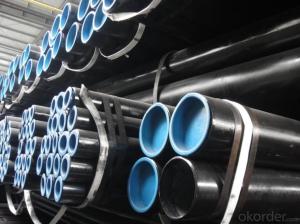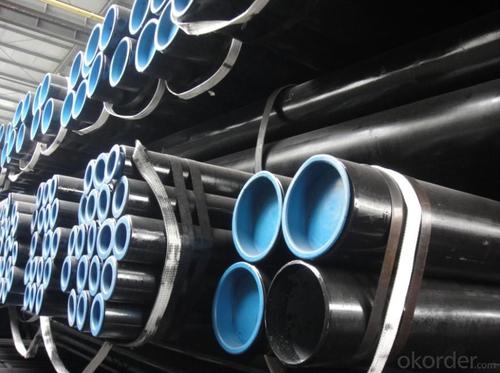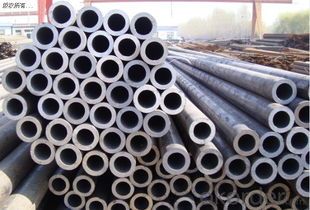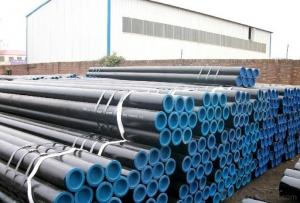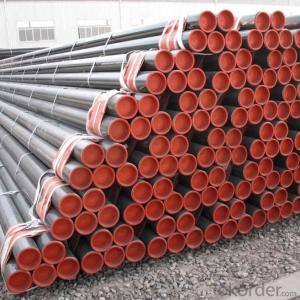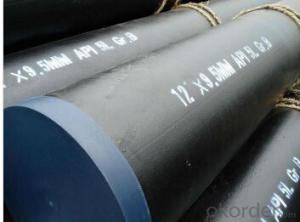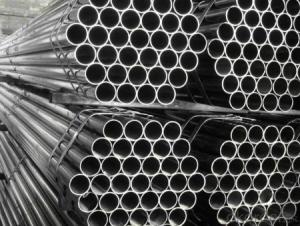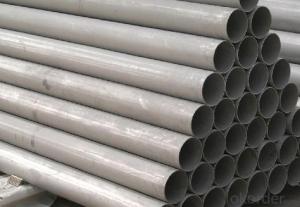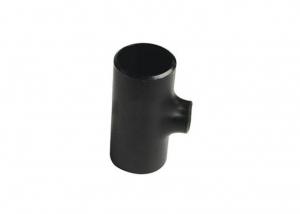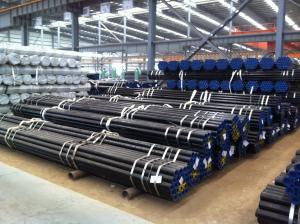Carbon Seamless Steel Line Pipe 12 Inch For Structure
- Loading Port:
- China Main Port
- Payment Terms:
- TT or LC
- Min Order Qty:
- 25 m.t.
- Supply Capability:
- 1000 m.t./month
OKorder Service Pledge
OKorder Financial Service
You Might Also Like
Product Description:
1、Structure of Carbon Seamless Steel Line Pipe 12 Inch For Structure:
Seamless pipe is formed by drawing a solid billet over a piercing rod to create the hollow shell. As the manufacturing process does not include any welding, seamless pipes are perceived to be stronger and more reliable. Historically seamless pipe was regarded as withstanding pressure better than other types, and was often more easily available than welded pipe.
2、Main Features of the Carbon Seamless Steel Line Pipe 12 Inch For Structure:
• High manufacturing accuracy
• High strength
• Small inertia resistance
• Strong heat dissipation ability
• Good visual effect
• Reasonable price
3、Carbon Seamless Steel Line Pipe 12 Inch For Structure Images:
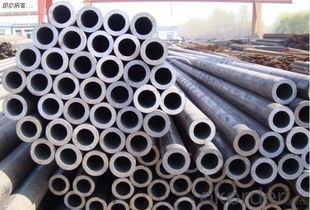
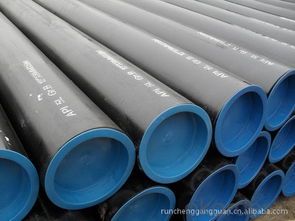
Packaging & Delivery
Packaging Details: | seaworthy package,bundles wrapped with strong steel strip |
Delivery Detail: | 15-30days after received 30%TT |
4、Carbon Seamless Steel Line Pipe 12 Inch For Structure Specification:
Standard | GB, DIN, ASTM |
Grade | 10#-45#, 16Mn |
Thickness | 8 - 33 mm |
Section Shape | Round |
Outer Diameter | 133 - 219 mm |
Place of Origin | Shandong, China (Mainland) |
Secondary Or Not | Non-secondary |
Application | Hydraulic Pipe |
Technique | Cold Drawn |
Certification | API |
Surface Treatment | factory state or painted black |
Special Pipe | API Pipe |
Alloy Or Not | Non-alloy |
Length | 5-12M |
Outer Diameter | 21.3-610mm |
Grade | 20#, 45#, Q345, API J55, API K55, API L80, API N80, API P110, A53B |
Standard | ASME, ASTM |
1.Material:20#(ASTM A 106/A53 GRB.API5LGRB,GB),45#,16Mn,10#.
2.Specification range:OD:21.3-610mm,WT:6-70mm,length:6-12m or according to the requirement of clients.
3.Excutive standards:GB,ASME API5L.ASTM A 106/A53,Despite of the above standards,we can also supply seamless steel pipe with standard of DIN,JIS,and so on,and also develop new products according to the requirements of our clients!
4.Surface:black lacquered,varnish coating or galvanized.
5.Ends:Beveled or square cut,plastic capped,painted.
6.Packing:bundles wrapped with strong steel strip,seaworthy packing.
5、FAQ of Carbon Seamless Steel Line Pipe 12 Inch For Structure:
①How is the quality of your products?
Our products are manufactured strictly according to national and internaional standard, and we take a test
on every pipe before delivered out. If you want see our quality certifications and all kinds of testing report, please just ask us for it.
Guaranteed: If products’ quality don’t accord to discription as we give or the promise before you place order, we promise 100% refund.
②How about price?
Yes, we are factory and be able to give you lowest price below market one, and we have a policy that “ for saving time and absolutely honest business attitude, we quote as lowest as possible for any customer, and discount can be given according to quantity”,if you like bargain and factory price is not low enough as you think, just don’t waste your time.Please trust the quotation we would give you, it is professional one.
③Why should you chose us?
Chose happens because of quality, then price, We can give you both.Additionally, we can also offer professional products inquiry, products knowledge train(for agents), smooth goods delivery, exellent customer solution proposals.Our service formula: good quality+good price+good service=customer’s trust
SGS test is available, customer inspection before shipping is welcome, third party inspection is no problem.
Any question, pls feel free to contact us !
- Q: What does seamless steel tube mean? What are the main uses? What are the classifications?
- The production process of seamless steel tube in general can be divided into two kinds of hot rolling and cold drawing, cold-rolled seamless steel pipe production process than hot-rolled billet to complex, first to three roller rolling and extrusion to sizing test, if the tube through the cutting machine cutting surface without crack growth response after cutting blank about one meter. Then enter the annealing process, annealing and pickling to use acid pickling liquid, should pay attention to the surface if there are a lot of bubbling, if there are a large number of bubbling pipe shows that the quality is not up to the standard. The appearance of cold rolling seamless steel tube shorter than hot-rolled seamless steel pipe, cold rolled seamless steel pipe wall thickness is generally higher than hot-rolled seamless steel pipe to be small, but the surface looks better than thick wall seamless steel pipe is more bright, rough surface is not too much, not too much burr diameter.
- Q: What are the different methods of pipe inspection for steel pipes?
- Steel pipes can be inspected using various methods. Here are some commonly employed techniques: 1. Visual Inspection: Trained inspectors visually examine both the exterior and interior of the pipe to detect any visible defects or abnormalities. This preliminary method is often used before more advanced techniques are applied. 2. Magnetic Particle Inspection (MPI): By applying a magnetic field to the steel pipe and iron particles to its surface, inspectors can identify surface cracks or defects. Leakage of magnetic flux caused by these abnormalities can be detected with this method, which is particularly effective for ferromagnetic materials. 3. Ultrasonic Testing (UT): UT is a non-destructive testing method that utilizes high-frequency sound waves to identify internal defects or anomalies in steel pipes. A transducer sends ultrasonic waves into the pipe, and reflections or echoes of the sound waves are analyzed to determine the presence of defects, such as corrosion, cracks, or variations in wall thickness. 4. Radiographic Testing (RT): This method involves using X-rays or gamma rays to create an image of the internal structure of the steel pipe. The resulting image reveals any defects, such as cracks, corrosion, or weld discontinuities. RT is commonly used for inspecting welded joints. 5. Eddy Current Testing (ECT): ECT is a non-destructive testing technique that utilizes electromagnetic induction to detect surface and near-surface defects in steel pipes. By passing a coil carrying an alternating current over the pipe's surface, any changes in electrical conductivity or magnetic field caused by defects are detected and analyzed. 6. Acoustic Emission Testing (AET): AET involves detecting and analyzing high-frequency acoustic signals emitted by materials undergoing deformation or damage. In the case of steel pipes, AET can monitor and identify defects like cracks, leaks, or corrosion by analyzing the acoustic signals emitted during service or under stress. These methods are just a few examples of commonly used techniques for inspecting steel pipes. The choice of method depends on factors such as the type of defect being sought, accessibility of the pipe, desired sensitivity level, and cost and time constraints. Using a combination of inspection techniques is often recommended to ensure a thorough assessment of steel pipes.
- Q: Can steel pipes be used for conveying solids?
- Yes, steel pipes can be used for conveying solids. Steel pipes are known for their high strength and durability, making them suitable for transporting various solid materials such as ores, coal, grains, and minerals. The smooth interior surface of steel pipes allows for efficient and smooth flow of solids, ensuring effective conveyance over long distances.
- Q: How are steel pipes used in the manufacturing of pressure vessels?
- Steel pipes are commonly used in the manufacturing of pressure vessels as they provide the necessary strength and durability to withstand high internal pressure. These pipes are welded or seamless and are often used as the main structural component of the vessel. They allow for the efficient flow of fluids or gases within the vessel and provide a reliable and secure containment system for various industrial applications.
- Q: Can steel pipes be used for pharmaceutical manufacturing plants?
- Yes, steel pipes can be used for pharmaceutical manufacturing plants. Steel pipes are known for their durability, strength, and resistance to corrosion, making them suitable for transporting various fluids and chemicals used in pharmaceutical production. Additionally, steel pipes can be easily sanitized and meet industry standards for cleanliness, making them a reliable choice for pharmaceutical manufacturing facilities.
- Q: Can steel pipes be used for gas lines?
- Yes, steel pipes can be used for gas lines. Steel pipes are commonly used for gas lines due to their high strength and durability, making them suitable for transporting natural gas or propane safely and efficiently.
- Q: How are steel pipes used in the oil and gas pipeline transportation?
- Steel pipes are used in oil and gas pipeline transportation due to their durability, strength, and resistance to corrosion. They are used to transport crude oil, natural gas, and other petroleum products over long distances. Steel pipes ensure the safe and efficient transfer of these resources from production sites to refineries and distribution centers, ensuring a reliable supply of energy for industries and consumers.
- Q: Which is better, galvanized steel pipe or stainless steel?
- Stainless steel is good.Stainless steel (Stainless Steel) is referred to as the stainless steel, the resistance of air, steam, water and other weak corrosive medium or with stainless steel known as stainless steel; while the resistance to chemical corrosion (acid, alkali and salt chemical etching) corrosion of steel called acid resistant steel. Because of the difference in the chemical composition of the two, and make their corrosion resistance is different, ordinary stainless steel is generally not resistant to chemical medium corrosion, and acid resistant steel are generally stainless steel.
- Q: Can steel pipes be used for sewage disposal systems?
- Yes, steel pipes can be used for sewage disposal systems. Steel pipes are durable, resistant to corrosion, and have high strength, making them suitable for conveying sewage and wastewater. Additionally, steel pipes can handle high-pressure systems and are often used in industrial and commercial applications for sewage disposal.
- Q: Are steel pipes suitable for oil and petroleum applications?
- Due to their exceptional strength, durability, and resistance to corrosion, steel pipes find extensive use in oil and petroleum applications. With the ability to endure high pressure and extreme temperatures, these pipes are ideal for the long-distance transportation of oil and petroleum. Moreover, steel pipes possess the added advantage of being able to withstand impact and vibrations, both prevalent in the oil and petroleum industry. Furthermore, their ease of welding and connecting facilitates efficient and cost-effective installation. In summary, steel pipes are the favored option for oil and petroleum applications, guaranteeing the secure and efficient conveyance of these valuable resources.
Send your message to us
Carbon Seamless Steel Line Pipe 12 Inch For Structure
- Loading Port:
- China Main Port
- Payment Terms:
- TT or LC
- Min Order Qty:
- 25 m.t.
- Supply Capability:
- 1000 m.t./month
OKorder Service Pledge
OKorder Financial Service
Similar products
Hot products
Hot Searches
Related keywords
